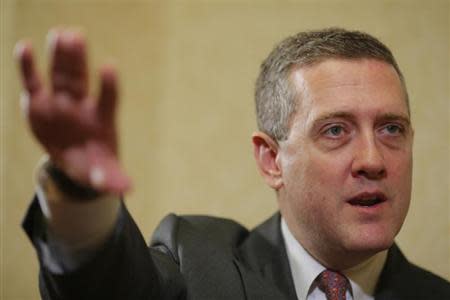Fed should start rate hikes in first quarter 2015, Bullard says
By Tara Joseph and Michael Flaherty HONG KONG (Reuters) - The Federal Reserve, which has kept short-term U.S. interest rates near zero since late 2008, should start raising them early next year with the aim of returning them to normal by the end of 2016, a top Fed official told Reuters on Thursday. "Mine is in the first quarter of 2015, as far as liftoff for the funds rate," St. Louis Federal Reserve Bank President James Bullard told Reuters Insider television, when asked for his view on when the U.S. central bank should make its first rate hike since 2006. "You have to keep in mind I tend to be a more optimistic member of the committee," he said. "I have a probably, a somewhat stronger forecast and a view about policy that suggests that maybe we should get up a bit faster than what some of the other members have." Bullard said he believes that by the end of 2016 the Fed should be targeting a "normal" short-term policy rate of 4 percent to 4.25 percent. By then, he told Reuters, the economy's growth and the labor market will probably have returned to normal, and inflation will have risen back up to the Fed's 2-percent target. That view marks Bullard as the most hawkish of Fed officials as policymakers weigh the delicate decision of when and how quickly to raise short-term borrowing costs. Interest rate projections released by the Fed last week showed only one policymaker felt the overnight federal funds rate should be at 4.25 percent by the end of 2016, while just one other felt it should be at 4 percent. The Philadelphia Fed has already said its president, Charles Plosser, feels it should be at 4 percent. Bullard does not vote on the Fed's policy-setting panel this year, but he takes part in policy discussions at the Fed's regular meetings in Washington. He will not rotate into a voting seat until 2016. Most other Fed policymakers see rates rising no higher than 3 percent by the end of 2016, largely because the economy in their view has been so damaged by the financial crisis and the 2007-2009 recession that it will continue to need support after the labor market and inflation return to near normal. The Fed has bought trillions of dollars in Treasuries and mortgage-backed securities to boost the economy and reduce unemployment, which rose as high as 10 percent in the aftermath of the recession. Now that the jobless rate has fallen to 6.7 percent, the Fed has begun dialing down its massive bond-buying program. Last week policymakers said they would trim their monthly purchases to $55 billion from $65 billion, and reiterated plans that put it on track to wind down the program before the end of the year. But the Fed has also said it will keep rates low for a "considerable time" after it ends the bond buying. Last week, Fed Chair Janet Yellen roiled markets by suggesting rate rises could come around six months after the bond-buying program ends. Bullard's view suggests he is pushing for an even earlier rate hike than Yellen or many of his other colleagues. "I think the thing that's helping us on the pace of removing accommodation is, inflation is pretty low," Bullard said. Inflation should rise back toward 2 percent this year, he said, laying the groundwork for interest-rate rises next year. The U.S. central bank publishes the views of its policymakers on the appropriate rate path, but does not identify who is making each individual projection. There are currently 16 active policymakers at the Fed. Markets have proved sensitive to those projections, with traders moving forward their expectations for a first Fed rate hike after last week's released showed some officials believed monetary policy should be tightened slightly more aggressively than they had felt in December. Traders of short-term U.S. rate futures are currently are making nearly even odds of a first Fed rate hike in April 2015, with better-than-even chance of a rate hike in June 2015. (Writing by Ann Saphir; Editing by Chizu Nomiyama)


